Esplora i risultati di ricerca web relativi a questo dominio.

In today's fast-paced world, prioritizing health and wellness has never been more important. And what better way to nourish your body and soul than through the art of cooking? Healthy cooking techniques not only enhance the flavor and texture of your meals but also preserve the nutritional ...
In today's fast-paced world, prioritizing health and wellness has never been more important. And what better way to nourish your body and soul than through the art of cooking? Healthy cooking techniques not only enhance the flavor and texture of your meals but also preserve the nutritional integrity of ingredients, ensuring that every bite isWith the right techniques and ingredients, healthy cooking can be a joyous and rewarding experience that nourishes both body and soul. By mastering a variety of cooking methods, incorporating plenty of fresh, whole ingredients, and seasoning thoughtfully with herbs and spices, you can create vibrant and wholesome meals that delight the senses and support your overall well-being. So, roll up your sleeves, sharpen your knives, and embark on a culinary journey of health and flavor – your body will thank you for it!And what better way to nourish your body and soul than through the art of cooking? Healthy cooking techniques not only enhance the flavor and texture of your meals but also preserve the nutritional integrity of ingredients, ensuring that every bite is as delicious as it is nourishing.Delve into a variety of techniques and strategies to help you master the art of healthy cooking, empowering you to create vibrant and wholesome meals that delight the senses and fuel your body with vitality.
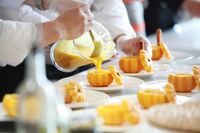
Explore innovative recipes and cooking techniques that cater to a variety of dietary preferences and restrictions. Cooking with Kids: Get the whole family involved in the kitchen and teach kids valuable cooking skills and healthy eating habits from a young age. Discover kid-friendly recipes, cooking activities, and tips for making cooking fun and educational for children. Cooking Challenges and Adventures: Step out of your comfort zone and embark on culinary ...
Explore innovative recipes and cooking techniques that cater to a variety of dietary preferences and restrictions. Cooking with Kids: Get the whole family involved in the kitchen and teach kids valuable cooking skills and healthy eating habits from a young age. Discover kid-friendly recipes, cooking activities, and tips for making cooking fun and educational for children. Cooking Challenges and Adventures: Step out of your comfort zone and embark on culinary adventures that push your boundaries and expand your culinary horizons.Cooking is more than just a chore; it's an art form that allows us to express creativity, connect with our cultural heritage, and delight our senses. In this post, we'll delve into the multifaceted world of cooking, exploring its rich history, diverse cultural influences, and endless culinary possibilities.Cooking is more than just a chore; it’s an art form that allows us to express creativity, connect with our cultural heritage, and delight our senses. In this post, we’ll delve into the multifaceted world of cooking, exploring its rich history, diverse cultural influences, and endless culinary possibilities. History of Cooking: From ancient civilizations to modern gastronomy, cooking has played a central role in human culture and evolution. Explore the origins of cooking techniques, ingredients, and culinary traditions that have shaped our global palate.Cooking Techniques: Delve into the art and science of cooking techniques, from basic methods like sautéing and braising to more advanced techniques like sous vide and molecular gastronomy.
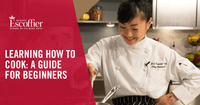
While it’s possible to learn ... learn to cook than attending culinary school.* *Information may not reflect every student’s experience. Results and outcomes may be based on several factors, such as geographical region or previous experience. Escoffier students in Austin proudly presenting paella. Many of the skills and techniques described above can be explored in Escoffier’s culinary arts ...
While it’s possible to learn on your own—or to learn in the workplace—there may be no faster way to learn to cook than attending culinary school.* *Information may not reflect every student’s experience. Results and outcomes may be based on several factors, such as geographical region or previous experience. Escoffier students in Austin proudly presenting paella. Many of the skills and techniques described above can be explored in Escoffier’s culinary arts classes.If you want to learn how to cook, start here. Tips for practicing techniques, conversion tables, and how to take the next steps beyond beginner. We’ve compiled a checklist of all of the essential questions into one handy tool: career options, culinary interest surveys, educational opportunities, and more.The best way to practice these techniques is to…use them! Look for recipes that utilize each method so you can get used to them. You can also practice a variety of cooking methods in culinary school. Students in the various programs at Auguste Escoffier School of Culinary Arts may practice many different cooking methods and learn to practice refined judgment with their techniques, deciding when it is ideal to bake, to roast, or even when to grill for the best results.There are cookbooks dedicated to pizza, Chinese wok cooking, vegan cakes, and vegetarian recipes–in short, there are cookbooks for just about any specialty. For a fully immersive experience taught by professional Chef Instructors, the answer is often culinary school. Escoffier offers degrees and diplomas in culinary arts, baking & pastry arts, plant-based culinary arts, hospitality and restaurant operations management, holistic nutrition and wellness, and food entrepreneurship, depending on the campus–Escoffier has campus locations in Austin, TX and Boulder, CO, as well as online options.
Danilo Alfaro has published more ... culinary techniques approachable to home cooks. ... If you want to become a culinary force to be reckoned with, you need to master certain basic skills. First, we'll go over a few basic cooking methods, like sautéing, roasting, and braising, followed by a rundown of some of the most fundamental procedures and basic preparations in the culinary arts...
Danilo Alfaro has published more than 800 recipes and tutorials focused on making complicated culinary techniques approachable to home cooks. ... If you want to become a culinary force to be reckoned with, you need to master certain basic skills. First, we'll go over a few basic cooking methods, like sautéing, roasting, and braising, followed by a rundown of some of the most fundamental procedures and basic preparations in the culinary arts.Not only is making homemade pancakes one of the most basic of culinary skills, once you've mastered the art of making batters, you'll also have a head start at making related items, like crepes, waffles, muffins, and cakes. ... The technique for cutting butter into flour is at the heart of any preparation featuring flaky dough, from biscuits to pie crust.Want to become a culinary force to be reckoned with? Here are 25 of the most important and fundamental cooking techniques that everybody ought to know.Anyone who can confidently and efficiently carve a Thanksgiving turkey without suffering a nervous breakdown or making a huge mess of things will be entitled to claim their place alongside the culinary Olympians. Wow your friends and family with these simple techniques. ... Cooking the perfect steak is on many home cook's bucket list. There's no need to spend a small fortune on professionally cooked prime beef at a restaurant. The perfect steak is achievable, and it's a lot easier than you might think. ... The art and science of culinary emulsions is the key to making a classic oil and vinegar salad dressing.
:max_bytes(150000):strip_icc()/perfect-hard-boiled-eggs-995510-6-5b0d7d3efa6bcc00376a46fd-5b21bd0904d1cf003c8c9aab.jpg)
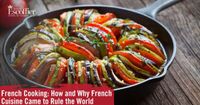
To become a great chef, one must be equipped with skills and techniques from different cultures and regions. However, French cooking inspires many types of cuisine and forms the foundation of fine dining. “ “Escoffier School of Culinary Arts opened my eyes to all these techniques that make ...
To become a great chef, one must be equipped with skills and techniques from different cultures and regions. However, French cooking inspires many types of cuisine and forms the foundation of fine dining. “ “Escoffier School of Culinary Arts opened my eyes to all these techniques that make my food the best I’ve ever cooked in my life.At Escoffier, we honor the countless contributions of Auguste Escoffier by exploring French techniques and an appreciation for great ingredients. If you’d like to improve your culinary skills from some of the best Chef Instructors, learn more about our culinary and pastry degrees and diplomas. ... *Information may not reflect every student’s experience. Results and outcomes may be based on several factors, such as geographical region or previous experience. This article was originally published on April 28, 2021 and has since been updatedBy providing a backbone of flavors and techniques, French cooking has supported many modern cuisines. However, exactly what is French cooking?Discover the steps that may be required to start your culinary career and earn the title of ‘chef’. ... French cooking is considered by many to be the most prestigious and respectable cuisine in the world. With its formal techniques, emphasis on fresh ingredients and simple flavors, pride in presentation, and rich and colorful history, French cuisine truly has come to rule the world, laying the foundations for many other styles and specialties. To become a skilled chef, you must have extensive knowledge of French cooking fundamentals.
Filet—fabricating a boneless cut or slice of meat or fish. Shuck—removing outer covering from corn or shellfish. Mise en Place (stocks, sauces, soups)—Everything in its place. All ingredients are measured, cut, peeled, sliced, etc. and placed in one area before the cooking process begins.
Food Handling: (food safety and food preparation techniques)—Handling, preparing and storing food to prevent food-borne illnesses from occurring. Proper food handling is based on four principles: clean, separate, chill and cook.Filet—fabricating a boneless cut or slice of meat or fish. Shuck—removing outer covering from corn or shellfish. Mise en Place (stocks, sauces, soups)—Everything in its place. All ingredients are measured, cut, peeled, sliced, etc. and placed in one area before the cooking process begins.Breading—coating fish or meat with bread crumbs or batter before cooking to seal in the foods natural moisture and provide a crunchy, delicious crust. Dry rubs—a mixture of coarsely ground herbs and spices used to add flavor and texture to meats.Marinades—liquids made of herbs, spices and an acid (usually citric, vinegar or alcohol) to add flavor and tenderize meat. The marinade is usually used before (meat is soaked in the marinade) and during the cooking process (meat is basted with the marinade).
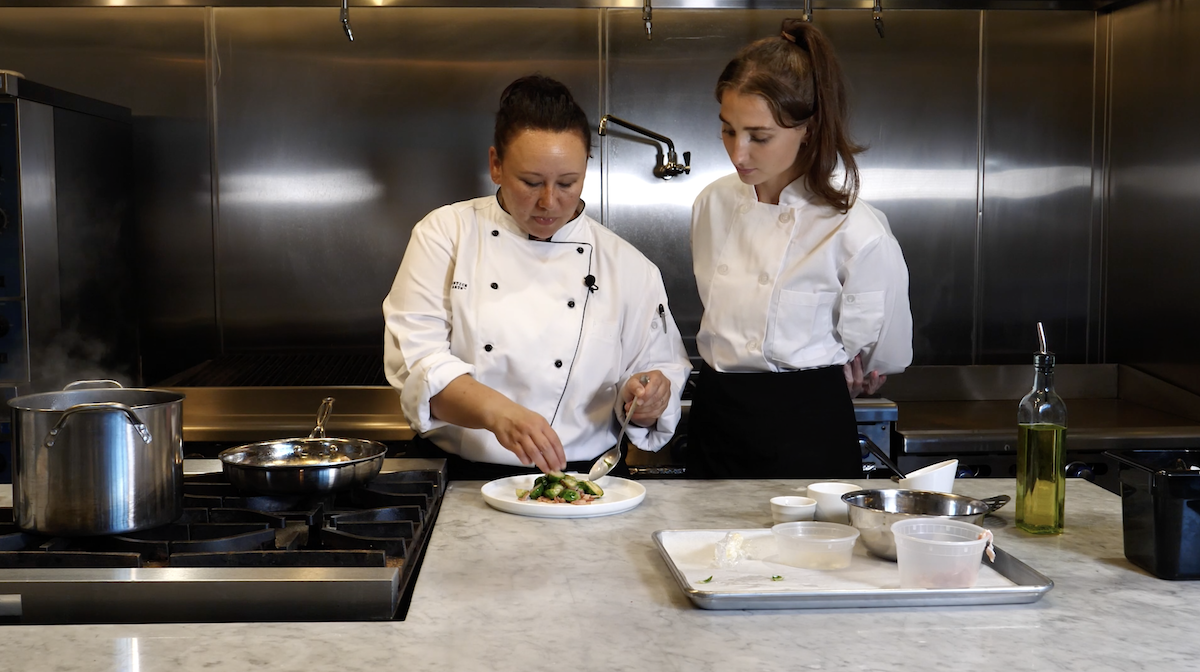

These skills also ensure that culinary ... techniques and recipes so that students fully grasp the fine details and underlying concepts. Related: 7 Tips for Improving Communication Skills · Culinary arts teachers remain on their feet continuously, like many educators. However, key aspects of cooking are particularly ...
These skills also ensure that culinary arts teachers can present intricate techniques and recipes so that students fully grasp the fine details and underlying concepts. Related: 7 Tips for Improving Communication Skills · Culinary arts teachers remain on their feet continuously, like many educators. However, key aspects of cooking are particularly physically intensive.However, some culinary professionals have the primary goal of sharing their knowledge with the next generation of cooks. If you're interested in working as a culinary arts teacher, you might benefit from gaining a better understanding of employers' expectations and the job's core duties. In this article, we review what culinary teachers do, the skills they use on the job, the steps to take if interested in becoming one and tips for succeeding in this career path.Outside of formal settings, some culinary arts teachers may lead classes for those who pursue cooking as a recreational activity or hobby. They might operate their own businesses or partner with a market or kitchen supply store that hosts them. Here are several skills culinary arts teachers rely on daily:Some culinary schools even offer bachelor's degrees, enabling you to gain greater academic exposure to business-related topics and liberal arts studies. Culinary programs can provide you a firm foundation in cooking basics, but work experience enables you to develop those skills to a much higher level.
Workshops, on the other hand, may ... skill or technique. For example, a cooking workshop might focus on mastering the art of sushi-making or perfecting the perfect soufflé. Workshops often provide a more in-depth learning experience, with a greater emphasis on practice and experimentation. For those who are serious about pursuing a career in the culinary industry, ...
Workshops, on the other hand, may be more intensive and focused on a particular skill or technique. For example, a cooking workshop might focus on mastering the art of sushi-making or perfecting the perfect soufflé. Workshops often provide a more in-depth learning experience, with a greater emphasis on practice and experimentation. For those who are serious about pursuing a career in the culinary industry, a culinary arts program is the way to go.In addition to general cooking classes and culinary arts programs, there are many specialized cooking courses that cater to specific interests or skills. For example: Baking and pastry arts courses focus on the art of baking and decorating, with students learning the techniques and skills needed to create elaborate desserts and pastries.BBQ and grilling courses teach students the art of outdoor cooking, covering topics such as meat selection, marinades, and grilling techniques. These specialized courses provide students with in-depth knowledge and skills in a specific area of cooking, which can be useful for those looking to start their own business or specialize in a particular type of cuisine. Many cooking courses offer certifications upon completion, but what do these certifications really mean? In the culinary industry, certifications can be an important indicator of a chef’s skills and expertise.When it comes to cooking, there’s more to it than just following a recipe. Mastering the art of cooking requires skill, patience, and practice, which is why many people enroll in cooking courses to hone their culinary skills. But have you ever wondered what these courses are called?
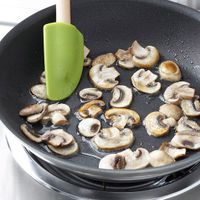
Take yourself from nervous amateur to confident cook with these essential cooking techniques and tips.
You can even cheat on this cooking technique by buying already minced garlic. Just know it won't have the same flavor as fresh garlic. Onions are full of flavor. They're the base of many savory recipes like soups and sauces. Compared to general knife skills, chopping an onion is almost its own art form.Baking bread is a great cooking technique to have in your culinary repertoire. There's a lot more out there than sourdough, too. Learn how to make simple quick breads that don't require yeast, like a crusty focaccia or classic sandwich bread.When you're new to cooking, words like "deglaze," "sauté," and "chiffonade" can be a little intimidating, but everything gets easier when you break it down to the basics. Start simple and apply these cooking techniques to some essential recipes. Once you've mastered a few go-to dishes and some easy skills, work your way up to longer, more involved recipes.Almost every recipe calls for cooking methods and techniques like chopping, slicing, or dicing. Get comfortable with a chef's knife to make these tasks feel quick and easy. Safety comes first, so start by learning basics like cleaning and sharpening your knife. It's an essential skill because dull knives are more dangerous than sharp knives.
Whether you work in a fine hospitality establishment or in a small French bistro in the South of France, you’ll need the following culinary art skills.
Whether you work in a fine hospitality establishment that caters to international guests, or you work in a small French bistro in the South of France, you’ll need to hone the following culinary skills. There’s no getting around it. If you do not have a passion for the culinary arts, you’ll never make a superb culinary arts professional.Food presentation is a key focus in culinary arts schools because it can be done in so many interesting ways. It’s part skill, part artistry. When you learn to plate dishes in an extraordinary way, you can whet the customers’ appetite just by the visual experience. Managing a kitchen is the job of the chef and the restaurant owner or manager.Whenever there are multiple types of personalities working together, there are bound to be tense moments of confrontation. And, some people are more difficult to contend with than others. When you study in a culinary arts school, you’ll learn skills that will help you to handle difficult people in a variety of situations.These are just some of the essential skills that you’ll need to be a successful culinary arts professional. The more you study this fascinating career, the more you’ll see that there is always more to learn.

Cooking is the art of preparing food for ingestion, commonly with the application of differentiated heating. Cooking techniques and ingredients vary widely across the world, reflecting unique environments, economics, cultural traditions, and trends. The way that cooking takes place also depends ...
Cooking is the art of preparing food for ingestion, commonly with the application of differentiated heating. Cooking techniques and ingredients vary widely across the world, reflecting unique environments, economics, cultural traditions, and trends. The way that cooking takes place also depends on the skill and type of training of an individual cook as well as the resources available to cook with, such as good butter which heavily impacts the meal.A culinary knife cut which involves cutting food (typically vegetables) into long thin strips. ... A traditional Hawaiian cooking method that utilizes an imu, a type of underground oven. ... A Japanese cooking technique in which various foods — most often chicken, but also other meat and fish — are deep fried in oil, similar to the preparation of tempura, but with a dredge in starch, rather than a liquid batter.A technique which involves coating pieces of raw meat or poultry in a mixture of cornstarch and liquid prior to cooking, frequently used in Chinese cuisine. ... Many common culinary terms exist that are unique to Vietnam.A culinary term indicating a garnish of almonds. A dish served amandine is usually cooked with butter and seasonings, then sprinkled with whole or flaked, toasted almonds.Cooking meat or fish slowly over a barbecue grill with indirect heat and smoke. ... Periodically pouring liquid over food as it roasts. ... A technique by which a fresh food such as a vegetable or fruit is briefly immersed in boiling water, removed after a timed interval, and then plunged into iced water or rinsed with cold running water (shocking or refreshing) to halt the cooking process.
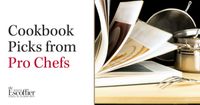
Outside of culinary books, books focused on business and hospitality may help you learn important skills for leading in the kitchen or restaurant setting. The Food Lab helps bridge the gap between home cooking and professional techniques. J. Kenji López-Alt uses science to explain why certain ...
Outside of culinary books, books focused on business and hospitality may help you learn important skills for leading in the kitchen or restaurant setting. The Food Lab helps bridge the gap between home cooking and professional techniques. J. Kenji López-Alt uses science to explain why certain cooking methods work.Discover 10 essential books for chefs, recommended by top culinary professionals, covering food science, flavor mastery, and creativity to elevate your skills!On Food and Cooking takes a deep dive into the science behind cooking—including the what’s and the why’s around foundational elements like temperatures and ingredients. That said, the book remains accessible for the layperson, so you don’t need to have a degree in food science to understand the content. Recommended by Escoffier Chef Instructors Jennifer Kempin, Eduardo Suarez, and Cheryl Herbert. Reading culinary books can be a helpful way for chefs to enhance their skills and stay inspired in the kitchen.I asked several of my fellow Chef Instructors at Auguste Escoffier School of Culinary Arts for their top book recommendations. Here’s a roundup of the most commonly recommended choices. After all, if you want to become a chef, well… reading chef-recommended books is a great place to start. For 35 years, this book has been beloved by home cooks and culinary professors alike.
Break down the barriers of home cooking and baking from fridge to table in these multi-day cooking classes. Novices and culinary wizards alike will benefit from hands-on instruction on cooking and baking basics like knife skills, cooking techniques, and creating bakery-worthy pastries.
Utilize the stove top and oven to discover differences between techniques, and the benefits of using aromatic stocks. Tackle recipes such as Ossobuco, braised short ribs, and rabbit fricassee. Week 6 – Master Sauces: Nothing elevates good home cooking like a masterful sauce! This course will explore the classic mother sauces and their myriad of flavors, textures, and colors. Applying the skills youve honed over the past five weeks, you’ll learn the secret to making a truly impressive dish.Week 1 – Vegetables, Grains, and Beans: Some techniques are best suited for cooking spring/summer vegetables, while others are best for fall/winter vegetables. Learn the differences while preparing soups, salads, sides, and vegetarian entrées. Week 2 – Poultry: Buying a whole chicken is more economical than buying parts, so it’s time you learned some de-boning methods, dividing the whole chicken into workable parts. Practice your moist heat and dry heat cooking skills while turning chicken breasts, wings, and legs into novel dishes.Week 6 – Company’s Coming: You are now ready to flaunt those skills! Working with the techniques and cooking methods covered in Techniques of Cooking I and the first 5 weeks of this series, build a complete menu to impress any dinner guests from appetizers though dessert.After mastering some impressive skills and techniques in Techniques of Cooking I, you will want to take your abilities to the next level.
If you have a passion for culinary arts and aspire to become an expert in the kitchen, mastering essential cooking techniques is an absolute must. As a leading culinary academy, we understand the significance of honing each of your skills to perfection.
In this blog, we present you with 20 indispensable cooking techniques that every kitchen enthusiast should learn to elevate their culinary prowess. Begin with the foundation of all culinary arts—knife skills.In the realm of professional cooking, the knife is not just a tool; it’s an extension of the chef’s skill and precision. The ability to transform ingredients through expert knife cuts is a fundamental technique that sets apart amateurs from the culinary artisans.Learn 20 essential cooking techniques from the experts at Slurp Culinary Academy. Master knife skills, searing, sauteing, roasting, braising, poaching, blanching, grilling, baking, emulsification, deglazing, reduction, marinating, frying, caramelization, mise en place, plating, food preservation, and tasting and seasoning.Slurp Culinary Academy focuses on starting with uniformly sized sticks before making precise crosscuts to achieve the desired brunoise. Mastering the art of professional culinary knife cuts is a transformative journey that elevates a chef’s skills to new heights. At Slurp Culinary Academy, we recognize the profound impact that these basic techniques have on culinary creations.

Culinary techniques improved with the introduction of earthenware and stoneware, the domestication of livestock, and advancements in agriculture. In early civilizations, the primary employers of professional chefs were kings, aristocrats, or priests. The divide between professional chefs cooking for the wealthy and peasants cooking for their families engendered the development of many cuisines. Much of the study of culinary arts ...
Culinary techniques improved with the introduction of earthenware and stoneware, the domestication of livestock, and advancements in agriculture. In early civilizations, the primary employers of professional chefs were kings, aristocrats, or priests. The divide between professional chefs cooking for the wealthy and peasants cooking for their families engendered the development of many cuisines. Much of the study of culinary arts in Europe was organized by Jean Anthelme Brillat-Savarin, famous for his quote "Tell me what you eat, and I will tell you what you are", which has since been mistranslated and simplified into "You are what you eat".Within the realm of the culinary arts, there is a wide array of different cooking techniques that originate from various cultures and continue to develop over time as these techniques are shared between cultures and progress with new technology. Different cooking techniques require the use of certain tools, foods and heat sources in order to produce a specific desired result.The professional kitchen may utilize certain techniques that a home cook might not, such as the use of an expensive professional grill. Modern culinary arts students study many different aspects of food.People working in this field – especially in establishments such as restaurants – are commonly called chefs or cooks, although, at its most general, the terms culinary artist and culinarian are also used. Expert chefs are in charge of making meals that are both aesthetically beautiful and delicious.The culinary arts, in the Western world, as a craft and later as a field of study, began to evolve at the end of the Renaissance period. Prior to this, chefs worked in castles, cooking for kings and queens, as well as their families, guests, and other workers of the castle.


But in general, the culinary arts is a creative, hands-on pursuit—literally. Cooks and chefs are constantly improving their skills and learning new things, even after culinary school. There’s a whole world of culinary traditions and techniques out there, and the industry is always evolving ...
But in general, the culinary arts is a creative, hands-on pursuit—literally. Cooks and chefs are constantly improving their skills and learning new things, even after culinary school. There’s a whole world of culinary traditions and techniques out there, and the industry is always evolving to cater to alternative diets and lifestyles.That’s why many culinary degree programs, like those at Auguste Escoffier School of Culinary Arts, also include some coursework in baking and desserts. “ “There was never a dull moment. I didn’t know how to bake, I didn’t know how to cook, but in Escoffier, I was able to learn all the skills.”*Escoffier’s Culinary Arts programs are designed to prepare students with technical proficiency, theoretical knowledge, and business-oriented skills. This combination can help prepare them to be both skilled cooks and excellent assets to the restaurant or foodservice establishment where they work. One of the first courses that Escoffier Culinary Arts students take is where they start to build the skills that they may use every day in their work.For example, later courses take what students have begun and add some pastry knowledge on top – like breakfast cookery, charcuterie, and garde manger. Remember that the line between the two can blur, so the best chefs often have skills in both culinary arts and pastry.
Grilling and broiling are quick cooking techniques, generally used for naturally tender meat, poultry or fish.
Explore a variety of cooking methods and techniques for more flavours, textures and tastes. A world class chef not only masters his preferred cooking method, but also wields the skills needed to cook up a storm using a variety of cooking and culinary techniques.Broiling tip: Many ovens turn off after reaching a certain temperature, leaving your food to cook in its own steam. To prevent this, prop the oven door open to allow heat to escape to keep the broiler burning. Characterised by letting the hot oil lock natural juices inside the meat, pan-fried foods have a richly-textured crust and a moist, savoury interior. Tip: For more flavour, use herbs or dried spices in your batter or season before pan-frying. This is a technique that cooks food rapidly in little or no oil over relatively high heat.Grilling and broiling are quick cooking techniques, generally used for naturally tender meat, poultry or fish.It keeps food fresh and its nutrients intact without altering the taste or appearance of the dish. Tip: Blanching is also a useful trick to remove membranes from meats, or skins from vegetables. Poaching involves either partially or fully submerging delicate ingredients (like fish or eggs) into a liquid that’s always kept just below boiling point. Tip: You can season by adding stock, wine, broth or additional ingredients (such as vegetables or fresh herbs) to the poaching liquid. A fundamental cooking method, boiling allows you to create a wide range of dishes with varying textures and tastes.

In conclusion, mastering the art of modern cooking requires a blend of traditional techniques, innovative thinking, and a willingness to adapt to the ever-changing culinary landscape. Embrace technology, understand flavor profiles, focus on quality ingredients, and let your creativity run wild.
In conclusion, mastering the art of modern cooking requires a blend of traditional techniques, innovative thinking, and a willingness to adapt to the ever-changing culinary landscape. Embrace technology, understand flavor profiles, focus on quality ingredients, and let your creativity run wild. By incorporating these essential techniques and tips into your culinary journey, you'll be well on your way to becoming a confident and skilled modern chef, ready to create gastronomic wonders in your very own kitchen.Cooking has always been considered an art, but with the advent of modern culinary advancements and a growing interest in gastronomy, it has evolved into a true masterpiece. The kitchen, once merely a functional space, has transformed into a creative hub where aspiring home chefs experiment with flavors, textures, and presentations.Master Cooking Techniques: While modern cooking celebrates creativity and innovation, it is crucial to have a solid foundation in fundamental cooking techniques. Whether it's mastering the art of sautéing, searing, grilling, or baking, these techniques lay the groundwork for more complex and inventive recipes. Invest time in honing your knife skills, as precision in cutting can significantly impact the texture and presentation of your dishes.Whether it's vegan, gluten-free, or keto-friendly options, being adaptable in your cooking style allows you to cater to a broader audience and ensures everyone can enjoy your culinary creations. ... Collaborate and Learn: Modern cooking is a collaborative and dynamic field, with chefs from all corners of the globe exchanging ideas and techniques.

Diploma in culinary arts · Mastering the techniques of roasting, grilling, frying, and baking forms the backbone of any kitchen professional, enabling them to deliver a range of flavors and textures. · Roasting is a basic cooking method that uses indirect heat to brown the surface of ...
To excel in culinary arts, it's essential to master a broad range of skills. These skills form the building blocks that enable chefs to create delectable dishes daily with innovation and flair. Let’s look at some of the main areas where you’ll need to build your skills. · Mastering multiple techniques is a significant part of honing culinary expertise as sophisticated cooking involves different methods, sometimes simultaneously.Take your culinary skills to a new level with our diploma and learn essential techniques from experts as well as the leadership skills that could put you in charge of your own kitchen. Diploma in culinary arts · Mastering the techniques of roasting, grilling, frying, and baking forms the backbone of any kitchen professional, enabling them to deliver a range of flavors and textures. · Roasting is a basic cooking method that uses indirect heat to brown the surface of food items such as meats and vegetables.Mastering the art of cooking requires more than just a fundamental understanding of ingredients and techniques. You also need to be adept at handling a variety of kitchen tools and equipment. Let's explore these in detail. · To excel in culinary arts, you will need to familiarize yourself with knives and cutting boards. Knowing how to handle knives is an essential skill if you intend to be a chef.You can develop the essential cooking skills through formal education and training. Many culinary schools offer respected culinary arts courses where you can acquire fundamental techniques under the supervision of professional chefs. Culinary classrooms offer students hands-on experience with kitchen equipment, ingredients, and a wide range of preparation methods.

These courses, often found in some of the best culinay schools, provide the essential skills needed to build confidence in the kitchen. This self-paced virtual program is perfect for those looking to build a strong foundation in the culinary arts. It covers an array of cooking techniques, starting ...
These courses, often found in some of the best culinay schools, provide the essential skills needed to build confidence in the kitchen. This self-paced virtual program is perfect for those looking to build a strong foundation in the culinary arts. It covers an array of cooking techniques, starting with basic knife skills and advancing to preparing more complex dishes.The program begins with essential techniques such as dough preparation, batter mixing, and chocolate tempering and gradually moves on to more advanced skills like creating intricate pastries and desserts. Whether you’re interested in perfecting your home baking or developing new skills, this program provides the tools to create beautiful pastries. The Fundamentals in Culinary Arts program is ideal if you’re looking to gain confidence in your cooking abilities.Dive into traditional ingredients and techniques, master iconic dishes like Adobo and Sinigang, and experiment with Indigenous flavors. While these programs may seem advanced due to their depth, they are accessible to anyone eager to deepen their culinary knowledge. Whether or not you have prior experience, these courses build a comprehensive skill set and can lead to a culinary arts diploma, offering valuable training for passionate cooks.The Bachelor of Science in Entrepreneurial Management Major in Culinary Arts combines advanced culinary training with business management education, providing students with the skills needed to excel in the competitive culinary world. As one of the courses to become a chef, it covers everything from advanced cooking techniques to financial management and marketing strategies, equipping participants with the tools to launch and manage a successful culinary enterprise.


:max_bytes(150000):strip_icc()/perfect-hard-boiled-eggs-995510-6-5b0d7d3efa6bcc00376a46fd-5b21bd0904d1cf003c8c9aab.jpg)





